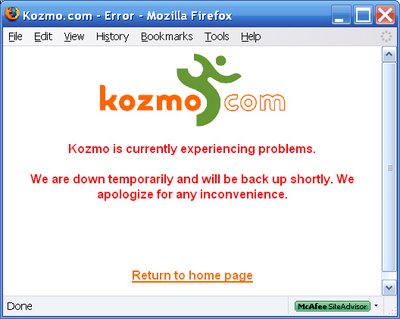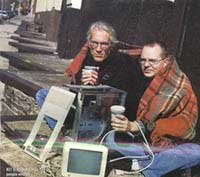 I've been digging through old CD-R disks in search of Steve Gilliard's lost writings for Netslaves. I figure it will take at least a year to locate all this material, and probably a decade to re-format it for the Web. Still, I think I owe it to my old pal to bring his lost writings back online. In the meantime, I'm discovering other artifacts from the Netslaves project that never made it online. Here is such an artifact: the story of an HTML programmer who worked for a corporation known as "Edler-Watson." This story was actually based on the memoir of someone who worked at Time-Warner's Pathfinder, but back in those days we changed the names because we were afraid of being blacklisted in Silicon Alley.The Story of Jane
I've been digging through old CD-R disks in search of Steve Gilliard's lost writings for Netslaves. I figure it will take at least a year to locate all this material, and probably a decade to re-format it for the Web. Still, I think I owe it to my old pal to bring his lost writings back online. In the meantime, I'm discovering other artifacts from the Netslaves project that never made it online. Here is such an artifact: the story of an HTML programmer who worked for a corporation known as "Edler-Watson." This story was actually based on the memoir of someone who worked at Time-Warner's Pathfinder, but back in those days we changed the names because we were afraid of being blacklisted in Silicon Alley.The Story of Jane
Jane Dantzig thought that she had seen it all. She’d worked in New York’s fast-paced New Media industry for a year, and paid her dues in high-tech sweatshops from Chelsea to Broad Street. Jane was a freelance HTML coder – a production grunt – one of the thousands of invisible people whose job it is to build, maintain, and refresh commercial Web sites so that the titanic dreams of their visionary masters can be realized, instead of sputtering to a halt on a broken link or a badly placed "DIV" tag.
Jane liked doing HTML – it would never make her rich, but it paid the bills. And she liked the independence the freelance life gave her even more. By being free to choose her clients, she could regulate the bullshit in her life, and control her destiny in a way that no full-timer, chained to the fate of her company, ever could.
Jane worked hard, didn’t goof off, rarely fucked up, and never kissed ass. But the mere fact that she controlled her destiny didn’t mean that she ruled Fate. And when Fate, in the guise of Challenger, Edler-Watson’s gigantic Web site, offered her a three-month production assignment in the Fall of 1995, Jane took the job.
It was a decision that led her into the Stygian depths of hell itself, and culminated in the single greatest disaster in the annals of New Media. For a brief 15 seconds that shocked the world, technology, human will, and reality itself suffered a simultaneous, cataclysmic failure whose ramifications are still being felt today.
It was the Day the Web Stood Still.
Hands-OnJane’s long road to disaster began when she accidently injured the left foot of her African Grey Parrot, who had let himself out of his cage, and had mischievously alighted on the top of her bedroom door. The door closed, the bird howled with pain, and Jane immediately rushed the parrot, whose name was "Mr. URL," to the Animal Medical Center on 92nd street. X-Rays proved the bird’s mashed leg wasn’t broken, and Mr. URL was released within two hours, which made Jane, who felt horribly guilty, feel a bit better. But Mr. URL’s emergency treatment would cost Jane $320, and this was enough to send Jane’s carefully calculated personal economy into disarray, because she just didn’t have the money.
Jane blamed herself for always being short on cash, but it was part and parcel of the freelance life she’d been living for about a year. Formerly employed as a full-time professional typesetter, Jane had given up the steady life of twice-monthly paychecks to pursue a Web builder’s career at age 28. Because she knew page design inside and out, and had figured out that HTML was a much simpler page description language than the cryptic markup tags she’d been using for years to compose business forms, she quit her job and set up her own design shop, called “Rational Bits” in early 1995.
Although freelance site building provided Jane with a much higher hourly income than she’d made as a typesetter, she still found it difficult to make ends meet. Jane didn’t spend extravagantly, nor did she pay more than $1,000 a month in rent for her 1-bedroom on Waverly Place. The problem lay on the supply side of the equation: in the fact that many of her clients held on to her invoices for months, or sometimes didn’t pay at all.
By the fall of 1995, Jane’s accounts receivables were about $9,000 – about half of this from a slick uptown design house that built Web sites for several international petrochemical companies that, as far as Jane knew, weren’t hurting for cash. She’d hassled her debtor for two months, received plenty of promises, apologies, and assurances – but no check.
Another small startup that Jane built sites for went belly up after its largest client went broke, and never paid Jane the $5,000 she was owed. With her quarterly self-employment taxes coming due September 1st, Jane’s bank account was approaching zero, and she feared that she’d soon be unable to even afford parrot food, which meant she’d have to keep Mr. URL alive on pizza crusts.
"That’s not going to happen, sweetie, don’t you worry”, Jane said, as the parrot balanced on his good leg and made clicking sounds that sounded exactly like her keyboard.
Scanning The ListIn the following days, Jane tried hard to drum up some business by continuously monitoring the job postings that scrolled across the New York World Wide Web Workers e-mail list. The WWWNY (or “Winnie”) list circulated among 2,000 Web professionals in New York, and it was a good place to hunt for freelance assignments. The Winnie list also provided a forum for a lot of quirky blowhards to rant endlessly about Aggro Software’s browser, or attack NetScathe’s flaky table support, but Jane tolerated the noise. She didn’t give a damn about the fate of VRML, or the future of interactivity – she just wanted to find a short-term job to pay her bird’s medical bill.
Unfortunately, most of the jobs posted to the list that week advertised intern positions that Jane was overqualified for.
“The fucking interns are ruining the job market”, Jane would complain.”
“Oh no”, Mr. URL answered back.
On Thursday, one listing did appear. It read simply:
HTML Production: Challenger
Long-term freelance opportunity. Must have extensive knowledge of HTML. Must be familiar with cross-platform, cross-browser compatibilities. Opportunity to expand your knowledge. Send email to production@challenger.com
Jane usually didn’t apply for long-term assignments, because most didn’t pay out until the project was completed. She’d already been burned twice speccing her time on long-term projects, and needed some instant cash.
She’d also heard weird things about Challenger from other HTML grunts who’d worked there.
“It’s chaos”, said one.
“Don’t go there. It’s a sick building”, said another.
“They use image-maps for everything”, said a third. But Jane fired off her resume anyway -- she didn’t want to feel that she’d left a stone unturned in her search for work.
On Friday, Jane was going over her $239 Bell Atlantic bill, when her mother called from Cincinnati. She hated to hit her mother up for money, but realized that if she didn’t, she’d be relinquishing her best shot of making it through the next week.
“Have you ever thought of trying to find a real job?”, Jane’s mother asked.
“Mom – I’ve got six jobs. I’m making more money freelancing than I could at a real job.”
“If you’re making more money, why are you asking me for a loan?”
“InterPetrol owes me $6,000. They’ve got to pay me -- I just don’t know when.”
After wrangling for a few more minutes, Jane’s mother agreed to mail her a check for $600, a sum that would go a long way in Cincinatti.
“Shit”, said the parrot.
“Well, it’s something”, Jane said.
Picking up FaresJane’s luck began to change the following week, when she got a call from LaserCrab, an ultra-hip downtown design house, asking her to come in for a couple of days of HTML coding. She’d worked at LaserCrab before, and had profoundly mixed feelings about going in, because its rarefied, design-driven atmosphere was, as she put it, “all sizzle and no steak.”
Jane also felt out of place among its pretentious crew of 20-something design mavens, who drank endless amounts of coffee, discussed Foucault and Hegel, and produced top-heavy, Java-dependent prototypes that seemed to crash every browser except the latest Mac version of NetScathe. Even though she felt like a hick in the place, Jane went down and spent three full days trying to unravel the weird code the designers’ WYSIWIG editors spat out.
The next week, she landed a two-day shift at Hedge-Downs, a publishing company that had recently fired 30% of its work force in a bloody restructuring, but still needed to crank out Web pages with gigantic tables comparing hundreds of computer components. Unlike LaserCrab, whose SoHo loftspace was a packed, dingy sweathouse of activity, Hedge-Downs plush offices were practically empty – either the editors were all at Comdex, or they’d all been fired.
Jane took Thursday and Friday off – her hands and wrists were hurting her, not so much from typing, but from clutching the crappy, non-ergonomic mouse that Hedge-Downs had made her use. Living with pain was something that Jane had grown used to, but as long as she gave herself a few days of recurperation from frenzied clicking, it seemed to disappear. She hoped she wasn’t doing permanent damage to her wrists, but really didn’t know – she hadn’t seen a doctor in a year, because she had no health insurance coverage.
She e-mailed her two invoices off – 32 hours of work, at $30 an hour – a grand total of $960 billed to two solvent clients who’d been pleased with her work. $30 an hour was the going rate for HTML production people of Jane’s caliber – fast coders who checked their work, proofread and corrected mistakes (even if they weren’t theirs), and made sure that all was safe and sound on the servers before clocking out for the night.
Short-TimerJane knew that neither RazorCrab nor Hedge-Downs would be likely to call her back soon – both companies were looking for a full-time coder that would work cheaper than Jane, and they’d probably fill the positions before too long. In truth, these companies only called in Jane when one of their people burned out – a fate that often stalked full-timers who were forced to do HTML, and nothing but HTML, for months without a break.
Jane actually enjoyed producing massive tables, cleaning up crappy code, and all the other minutia associated with hand-crafting HTML pages. But she couldn’t bear the thought of doing HTML all day, every day. Beyond the torture it inflicted on her extremities, Jane also suspected that too much Web production could actually drive one crazy. After a certain point, it became like Chinese Water Torture – a sinister thing whose evil lay in the fact that none of its victims ever believed that innocent little drops of water could be capable of inflicting such crippling psychic pain.
The fear of mindless repetition, beyond any any other reason, lay at the root of Jane’s hatred for permanent jobs. It wasn’t, as her mother suggested, that Jane was “afraid of commitment”, or “suspicious of long-term relationships”. Jane had nothing against men, beyond the fact that most were hopelessly messy creatures who felt they’d been granted an inaliable right to interpose themselves in Jane’s life, and talk for hours – usually about themselves. In this respect, they were like Mr. URL, but took up much more space.
If Jane had had the time to see a shrink, he might have advised her that her strong bias towards “independence” might be causing her to miss out on things that only long-term relationships bring: security, a family, a sense of being more than a nomad who lived by the clock. But Jane had no desire to change her life – it hitch her chain to some flaky man, or an even flakier Internet startup. And Jane’s reluctance to “commit” to long, drawn-out affairs of the heart, or of the workplace, stemmed from the simple fear of boredom – the dreary, mind-numbing sameness that, like Water Torture, ultimately became unbearable.
The ChallengeOn Saturday, around six PM, the phone rang – it was Challenger’s Head of Production, calling about the resume she’d sent in a week before.
“I need coders”, the voice said. “Your resume looks good. What’s your availability?”
“Well, this week is clear.”
“Report to 3724A. You’ll need a visitor’s pass. Be there at 10:00”.
“But I…”
The phone clicked. It was the shortest conversation Jane had ever had.
“Oh no”, said the parrot.
“Well, we do need the money”, Jane answered.
On Sunday, Jane was sleeping late, when the phone rang again.
“Where are you?”, asked the voice, and it took a few seconds for Jane to properly associate it with Challenger.
“I thought you were talking about Monday”, Jane said.
“I’m talking about now”, he said. “Can you make it in or not?”
She looked at her clock radio, which read 10:20.
“I’ll be in as soon as I can”, she said.
Jane took the 6th Avenue subway up to the Edler-Watson building – a 50-story, modernistic slab of concrete in the low ‘50’s. She got a visitors’ pass from a sleepy guard in the visitor’s center, and waited for the elevator. The lobby was empty and echoic – a mournful mausoleum to 1950’s modernism. But when she stepped out on the 37th Floor, and was buzzed through Challenger’s security system, Jane entered a scene of bustling activity – people were darting back and forth among a long corridor of cubicals that stretched the entire length of the building’s East wall.
Jane began to sweat – it was hot in the massive room, and clouds of condensation had formed on the inner services of the sealed pane glass windows. She wandered through the bullpen of cubes, and circled back to the entrance, disoriented and confused. At last she found Room 3724A, a small, windowless office that she’d walked right by when she came in, mistaking it for a utility closet.
“I’m Jane Dantzig”, she said to the man hunkered down behind two gigantic monitors on a cluttered wooden desk.
“Good”, he said, without looking up. He rustled with some forms, and handed them to her. “You need to fill these out, and these, and these. Your rate is $20 an hour. Fill out the time sheet when you’re done.”
She filled out the tax forms and waited for more instructions from the man, but he was busily clicking away at something.
“It’s pretty hot in here”, Jane said.
“Building services doesn’t like running the air conditioners on weekends”, he said.
“What would you like me to work on?”, Jane asked.
“We’re redesigning the site today”, he said. “I need a report on broken URLs. Find a vacant cube.”
“Do you want me to fix them?”
“No. Just a report”.
Jane found an unoccupied office near Challenger’s coffee machine, and logged on to the network. She launched NetScathe, and began tooling around the Challenger site – a massive collection of content from about 80 of Edler-Watson’s magazines. She explored the sites’s top level pages, and although they were slow-loading, image-mapped monsters, none of them were actually broken.
But when Jane began exploring the pages of the magazines themselves, she found hundreds of errors, and had soon filled up an entire page with notes on their locations. By the time she was ready to leave, around 8:00 PM, she had accumulated a list of about 1,400 hundred bad links.
The Production Head studied her printout. “That’s good. That’s very good”, he said. “Can you come back tomorrow?”
“I’d like to, but I usually get $30 an hour”, Jane said.
“You’re just checking links. This isn’t rocket science.”
“Yes, but if I do this gig, I can’t do my other jobs, which do pay me $30 an hour”, Jane said.
“Well, I could probably use someone on PowerStager. It’s rolling out next week. I tell you what - I’ll pay you $25 an hour, but we’d have to train you, so you’d have to agree to stick around to make it worth our while.”
“All right”, Jane said.
PowerStagerThe next day, Jane began to learn how to operate PowerStager, an elaborate piece of software designed in-house by Challenger’s software engineers to streamline the way content was uploaded to the site. PowerStager was built to correct a problem that had plagued Challenger from the beginning – a problem known as “Update Gridlock”.
Challenger, like many large Web sites, used two physical machines to store its massive collection of content: a public server, and a staging server. Editors would “fetch”, or FTP new content to the staging server, and then, after a period of time, the staging server would refresh the public server, so that users could see the new stuff.
Unfortunately, as Challenger aggregated more content, and refreshed content more frequently, the staging queue often backed up, causing the time lag between server refreshes to grow to a point where it might take three or more hours for a “fresh” news item to appear on the public servers.
Challenger’s Editor-in-Chief, Jeff Marshall, yelled and screamed about Update Gridlock, because it caused Challenger to get “scooped” on breaking news stories. Others were screaming too – sometimes, the site’s hopelessly constipated content queue would actually cause the staging server to fail, which caused a wave of hair-pulling and subcritical brain embolisms to sweep through Challenger'’ short-tempered crew of editors. Each knew that in a matter of moments, their phones would light up, and they’d be treated to obscenity-laced tirades from their Content Partners, who couldn’t update their sites.
PowerStager, on the other hand, was designed to selectively bypass the staging server, so that Challenger’s editors could write content directly to the public server – a very powerful, but very dangerous capability that filled the tech team with dread. The potential for disaster -- through accident, miscalculation, or madness – was very real, because PowerStager provided a way for technically inept editors to inadvertently overwrite the entire site – the equivalent of typing “FORMAT C:\” in a DOS window. If this happened, the technicians’ only recourse would be to restore Challenger from an archived tape drive, a maddening process that took them three days to finsh in their dark, subterranean server farm complex across the street.
To prevent any unauthorized overwriting, PowerStager’s Web-based interface was deliberately made very complicated, to mislead Challenger’s editors into believing it could only update a single file at a time. As a secondary security measure, PowerStager included a feature which forced editors to click through three seperate “ARE YOU SURE YOU WANT TO DO THIS?” screens before they could update anything. As a final line of defense, PowerStager automatically created a log file capturing the IP address of the updater, and, it was rumored, “did a lot of other things” to identify editors screwing with the public servers without permission.
BugsWhile Jane had no trouble understanding the theory behind PowerStager, she found its practical operation somewhat erratic. When she tried using the software to move some non-critical test files to a test directory, she observed that it only worked about half the time. Sometimes the GIF would arrive corrupted, and HTML files didn’t always arrive intact either. PowerStager also seemed to slow down at certain points in the day, which meant that Jane had to wait around for 10 minutes before she could get through all the “ARE YOU SURE YOU WANT TO DO THIS?” screens.
She called up her contact on the Tech Side about this.
“We know all about the bugs”, he said.
“Is it something I should worry about?”
“When it launches, they’ll be gone”, he said.
By Wednesday, Jane noticed that some of PowerStager’s bugs had been eliminated, but others were mysteriously appearing. Sometimes PowerStager would “hang” in the middle of an operation, forcing her to reboot her machine. Sometimes her hard drive would start spontaneiously spinning by itself – Macs had a tendency to that, of course – but it still seemed peculiar, and Jane wondered if PowerStager wasn’t probing her machine for reasons of its own. Later in the afternoon, Jane received a real scare when a file she was working on completely vanished from her desktop, even though she hadn’t deleted it.
“That’s a new one”, said the engineer. “It may have something to do with the resolver.”
“Sounds a lot like Rocket Science”, Jane said.
The OJ FilesBefore Jane left for the weekend, the Production Head specified that she make a special attempt to arrive early on Monday – something important was going on.
“Another redesign?”, Jane asked.
“No, it’s this OJ thing”, he said.
“What’s the OJ thing?”
“Aren’t you following the trial?”
“No”.
“Well forget about it. Just be in place early. It’s probably going to be a busy day.”
“OK”, Jane said, signing her time slip.
Jane spent a quiet weekend at home, and didn’t think much about OJ Simpson, Challenger, or PowerStager. She was aware that OJ had been on trail in Los Angeles for months, but had more or less blanked it out. The whole thing seemed to have very little to do with her life – it happened far away, in a city that she didn’t like very much.
But Challenger felt very different about the fate of OJ Simpson, and one of its most popular subsites, OJ Central, had served as the Internet’s greatest single touchstones for Web users who, in many cases, seemed obsessed by the whole saga. OJ Central provided an interactive map of the murders, daily trial transcripts, and a message board which teemed with thousands of ranting, raving, and hand-wringing opinions on what the whole mess meant to the future of the Western World.
Like the networks, Challenger was making big bucks off of OJ, and knew, as Jane did not, that it was likely that the Simpson trial would likely reach a verdict on Monday, October 3rd. So to capitalize fully on their expanded OJ coverage, Challenger had made it known to OJ Central’s users that it would be the first site to announce OJ Simpson’s verdict, within minutes of its rendering.
Over the weekend, an emergency OJ team camped out in the overheated confines of Edler-Watson’s 37th Floor, planning the best way to make sure that nothing went wrong. Although everyone on the OJ team believed that Simpson would surely be found guilty, they didn’t take any chances, so the Art Department was instructed to prepare two different, image-mapped GIFs to replace Challenger’s default home page. One read “GUILTY!”, and showed a dour, depressed OJ Simpson appearing to scream at the Judge. In an inspired flourish, the GIF also included within its sidebar the ominious notice that said: “LA POLICE ON ALERT”.
The second home page, “OJ Innocent”, showed OJ Simpson in a completely different pose: quiet, somber, and beautifically grateful to the jury that had let just him off the hook. Obviously, no “reports” of the LA Police’s alert status were included in this image. Temporary pieces of ersatz text reportage were hammered out by Challenger’s News Editor, to serve as placeholders until someone could grab enough text from an incoming Reuters wire report to flesh things out in more detail.
By late Sunday night, all of the new OJ content had been finished, the weary team had retired for the night, and all the OJ Files were plopped into two folders, named GUILTY and INNOCENT, which sat on Challenger’s LAN.
ApocalypseAt 8:30AM on Monday, Jane took a position in her cube, and waited for instructions from her masters. It was quiet in the Challenger’s massive bullpen, but things came to life when its staffers started appearing around 9:30, with members of the OJ team looking sleepy and unkempt. A large 21-inch television mounted on the wall was turned on at 10:30, and Jane listened into the pre-verdict coverage on CNN. The OJ jury had been sequestered all weekend, and, and reliable sources said that they were finally ready to pronounce a definitive verdict on the football player’s crime.
At 11:30, a small crowd began to gather around Jane’s cube, which was right below the big TV. Minutes later, Pathfinder’s Production Head soon appeared at Jane’s cube, and showed her where the INNOCENT and GUILTY folders resided on the LAN.
“Okay, all you have to do is make sure that the right files go up”, he said. “Just select the right folder” when I say “Go”, and get through those damned confirmation screens as fast as you can”.
“Right”, Jane said.
At 11:59, all of the major networks pre-empted their normal programming, and switched to a live satellite feed from the LA County Courthouse. The OJ jury filed out of its deliberation room, and the foreman began speaking into a microphone.
"We find the defendant OJ Simpson... Not Guilty of the crimes..."
"Go," said the Production Head.
Jane dragged the INNOCENT folder into PowerStager’s “put” window, and hit OK. She rapidly clicked three times more, to get through the confirmation screens. She then switched to Challenger’s home page, and hit “Reload” on her browser.
It was a moment that was just like the expanding, slow-motion, head-through-the-windshield impact of a terrible car crash. All the moments of Jane’s life seemed to pass through the terrible funnel of that frozen five seconds. Time stood still, and there for all the world to see on Challenger’s public servers, was the wrong home page – the one that said “OJ Guilty: LA Police on Alert”.
Jane had just uploaded the wrong fecking file.
“SHIT!”, the Production Head said. “Oh Shit! UPLOAD IT AGAIN. AGAIN.”
Jane repeated the steps in PowerStager. She hit reload again. An interminable moment passed as the browser’s cache refreshed.
“OH, Thank God. Thank God. It’s OK. It’s the right one”, said the Production Head, his face whitish, drained of blood.
A relieved murmer rippled through the room. People started to return to their cubes, although they remained in a state of shock, because few among Challenger’s staff believed that OJ Simpson was innocent of murder.
But within an hour, there was more bad news. Although the OJ GUILTY GIF had been on the public servers for less than fifteen seconds, a user in the Far East had retrieved the file from his cache, posted it to a Web site, and was spamming USENET with news of Challenger’s mistake. All through that terrible afternoon, “OJ GUILTY” mirror sites sprang up all over the Web. By five o’clock, Ruport Murdoch’s own site, iGuide, was running a headline story comparing Challenger’s journalistic fumble to the legendary “Dewey Defeats Truman” newspaper debacle of 1948.
"Jane," said the Production Head. “We’re going to have to talk about this”.
And with that, he called her into his office, and closed the door.
“What do you mean, I’ve got to appear at a hearing?”, Jane asked the Production Head.
“It’s not a hearing – it’s more of a fact-finding conference”, the man said.
“I don’t think I want to get involved in this.”
“Well, the Editor-in-Chief wants to get to the bottom of this. There’s a lot of fingerpointing going on here – the Editors are blaming the Art Department, the Art Department is blaming the Tech Side, you’re blaming the software, and some people are blaming you.”
“I know the difference between a folder called INNOCENT and one called GUILTY”.
“I believe you, but can you convince them?”
“Look mister. If you’re going to make me the central figure in some kind of an inquest, you’re going to have to pay me a lot more than $25 an hour.”
“What’s your price?”
“$50”.
“It’s high”, the man said, “but I’ll pay it”.
“Yeah, well I’ve got better things to do”, Jane said, and walked down the corridor toward the elevator. She never came back.
VerdictJane was the only one of the various participants in the Great OJ Disaster who refused to attend the grueling, day-long inquest that was held to investigate the incident. As a result, she was fully blamed for the whole thing – one editor speculated that Jane, being a woman, couldn’t bring herself to believe that OJ Simpson was really innocent of murdering his wife. Instead, in a “trancelike state of denial”, she’d acted reflexively, without thinking, and grabbed the wrong folder. One woman at the inquest objected to this interpretation, and suggested that Jane was probably just a closet racist, who just couldn’t handle the truth.
But the inquests final report rejected both of these interpretations, and simply concluded that Jane was an incompetent who should never have been hired in the first place. She was quickly removed from Challenger’s list of “approved” freelancers, and was never called back to the site.
EpilogueAlthough PowerStager’s role in The Great OJ Disaster briefly surfaced at the inquest, no one seriously believed that such an elegant piece of software could possibly have mixed up the INNOCENT and GUILTY files, and it was placed in service the next day. All ran well for a couple of weeks, until, one morning, Challenger’s entire site disappeared from the Internet, just after the News Editor updated a small, insignificant file to the public servers. After technicians spent a week restoring the massive site, PowerStager was quietly taken down for “routine maintenance”, and was never returned to service.
Jane, on the other hand, is still in service, and continues to live with her parrot on Waverly Place. She still builds Web sites in New York, and still makes about $30 an hour. She rarely thinks about OJ Simpson, or the Great OJ Disaster, but admits that if she ever saw another copy of PowerStager, she’d run a knife through its heart.
No jury would ever convict her.
Labels: Netslaves, Silicon Alley History
 I've been publishing Ghost Sites of the Web since the Summer of 1996, and it's been a great ride. But as live forces its changes upon us, we must adapt. This year, I've gone through two tragedies that have completely altered my life. Both my beloved mother and sister committed suicide earlier this year. I will probably spend the rest of my life trying to understand how this could happen, faulting myself for failing to prevent it. One can only try to move through such an experience on a day by day basis, and try to keep moving, because depression, it's said, "has a hard time hitting a moving target."
I've been publishing Ghost Sites of the Web since the Summer of 1996, and it's been a great ride. But as live forces its changes upon us, we must adapt. This year, I've gone through two tragedies that have completely altered my life. Both my beloved mother and sister committed suicide earlier this year. I will probably spend the rest of my life trying to understand how this could happen, faulting myself for failing to prevent it. One can only try to move through such an experience on a day by day basis, and try to keep moving, because depression, it's said, "has a hard time hitting a moving target."
















